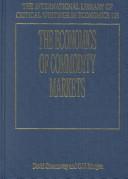| Listing 1 - 5 of 5 |
Sort by
|
Periodical
Abstract | Keywords | Export | Availability | Bookmark
 Loading...
Loading...Choose an application
- Reference Manager
- EndNote
- RefWorks (Direct export to RefWorks)
Hematology --- Blood --- Blood. --- Blood Banks. --- Blood Substitutes. --- Blood Transfusion. --- Hematologic Diseases. --- Hematology. --- Haematology --- Hematological Diseases --- Blood Diseases --- Blood Disease --- Disease, Blood --- Disease, Hematologic --- Disease, Hematological --- Diseases, Blood --- Diseases, Hematologic --- Diseases, Hematological --- Hematologic Disease --- Hematological Disease --- Blood Transfusions --- Transfusion, Blood --- Transfusions, Blood --- Artificial Blood --- Artificial Erythrocytes --- Artificial Hemoglobin --- Blood, Artificial --- Erythrocyte Substitutes --- Hemoglobin Substitutes --- Red Cell Substitutes --- Artificial Bloods --- Artificial Erythrocyte --- Artificial Hemoglobins --- Blood Substitute --- Bloods, Artificial --- Cell Substitute, Red --- Cell Substitutes, Red --- Erythrocyte Substitute --- Erythrocyte, Artificial --- Erythrocytes, Artificial --- Hemoglobin Substitute --- Hemoglobin, Artificial --- Hemoglobins, Artificial --- Red Cell Substitute --- Substitute, Blood --- Substitute, Erythrocyte --- Substitute, Hemoglobin --- Substitute, Red Cell --- Substitutes, Blood --- Substitutes, Erythrocyte --- Substitutes, Hemoglobin --- Substitutes, Red Cell --- Blood Banking --- Bank, Blood --- Banking, Blood --- Bankings, Blood --- Banks, Blood --- Blood Bank --- Blood Bankings --- Water --- blood --- Blood Banks --- Blood Substitutes --- Blood Transfusion --- Hematologic Diseases --- Internal medicine --- Body fluids --- Fear of blood --- Fluorocarbons --- Bloodless Medical and Surgical Procedures --- Artificial Cells --- Diseases --- Blood Donation
Book
Year: 1999 Publisher: Washington, D.C., The World Bank,
Abstract | Keywords | Export | Availability | Bookmark
 Loading...
Loading...Choose an application
- Reference Manager
- EndNote
- RefWorks (Direct export to RefWorks)
May 2000 - How will stronger patent rights in developing countries affect transnational corporations' behavior in and toward those countries? How will market structure and consumer welfare be affected by extending patent protection to products that could previously be freely imitated? Will research-based transnational corporations devote more resources to developing technologies relevant to needs in developing countries? To address questions about how stronger patent rights will affect India's pharmaceutical industry, Fink simulates the effects of introducing such protection - as required by the World Trade Organization Agreement on Trade-Related Intellectual Property Rights (TRIPs) - on market structure and static consumer welfare. (India must amend its current patent regime by 2005 and establish a transitional regime in the meanwhile.) The model Fink uses accounts for the complex demand structure for pharmaceutical goods. Consumers can choose among various drugs available to treat a specific disease. And for each drug, they have a choice among various differentiated brands. Fink calibrates the model for two groups of drugs - quinolonnes and synthetic hypotensives - using 1992 brand-level data. In both groups, a subset of all available drugs was patent-protected in Western Europe but not India, where Indian manufacturers freely imitated them. The simulation analysis asks how the market structure for the two groups of drugs would have looked if India had granted patents for drugs. It does not take account of the fact that stronger patent protection will not apply to existing drugs and that the Indian government might be able to restrain high drug prices by imposing price controls or granting compulsory licenses. Still, Fink concludes that if future drug discoveries are mainly new varieties of already existing therapeutic treatments, the effect of stronger patent protection is likely to be small. If newly discovered drugs are medicinal breakthroughs, however, prices may rise significantly above competitive levels and static welfare losses may be large. If demand is highly price-elastic, as is likely in India, profits for transnational corporations are likely to be small. But if private health insurance is permitted in India, reducing the price-sensitivity of demand, patent-holders' profits could increase substantially. In light of the fact that the TRIPS Agreement strengthens patent rights in most developing countries, pharmaceutical companies may do more research on, for example, tropical diseases. This paper - a product of Trade, Development Research Group - is part of a larger effort in the group to investigate the economic consequences of multilateral trade agreements. The author may be contacted at cfink@worldbank.org.
Access to Markets --- Advertising --- Brand --- Brands --- Commercialization --- Competition --- Demand --- Economic Theory and Research --- International Economics & Trade --- Law and Development --- Macroeconomics and Economic Growth --- Market --- Market Structure --- Marketing --- Markets and Market Access --- Price --- Price Controls --- Price Increases --- Prices --- Product --- Products --- Publicity --- Real and Intellectual Property Law --- Sales --- Substitute --- Substitution --- Trademarks
Book
Year: 1999 Publisher: Washington, D.C., The World Bank,
Abstract | Keywords | Export | Availability | Bookmark
 Loading...
Loading...Choose an application
- Reference Manager
- EndNote
- RefWorks (Direct export to RefWorks)
May 2000 - How will stronger patent rights in developing countries affect transnational corporations' behavior in and toward those countries? How will market structure and consumer welfare be affected by extending patent protection to products that could previously be freely imitated? Will research-based transnational corporations devote more resources to developing technologies relevant to needs in developing countries? To address questions about how stronger patent rights will affect India's pharmaceutical industry, Fink simulates the effects of introducing such protection - as required by the World Trade Organization Agreement on Trade-Related Intellectual Property Rights (TRIPs) - on market structure and static consumer welfare. (India must amend its current patent regime by 2005 and establish a transitional regime in the meanwhile.) The model Fink uses accounts for the complex demand structure for pharmaceutical goods. Consumers can choose among various drugs available to treat a specific disease. And for each drug, they have a choice among various differentiated brands. Fink calibrates the model for two groups of drugs - quinolonnes and synthetic hypotensives - using 1992 brand-level data. In both groups, a subset of all available drugs was patent-protected in Western Europe but not India, where Indian manufacturers freely imitated them. The simulation analysis asks how the market structure for the two groups of drugs would have looked if India had granted patents for drugs. It does not take account of the fact that stronger patent protection will not apply to existing drugs and that the Indian government might be able to restrain high drug prices by imposing price controls or granting compulsory licenses. Still, Fink concludes that if future drug discoveries are mainly new varieties of already existing therapeutic treatments, the effect of stronger patent protection is likely to be small. If newly discovered drugs are medicinal breakthroughs, however, prices may rise significantly above competitive levels and static welfare losses may be large. If demand is highly price-elastic, as is likely in India, profits for transnational corporations are likely to be small. But if private health insurance is permitted in India, reducing the price-sensitivity of demand, patent-holders' profits could increase substantially. In light of the fact that the TRIPS Agreement strengthens patent rights in most developing countries, pharmaceutical companies may do more research on, for example, tropical diseases. This paper - a product of Trade, Development Research Group - is part of a larger effort in the group to investigate the economic consequences of multilateral trade agreements. The author may be contacted at cfink@worldbank.org.
Access to Markets --- Advertising --- Brand --- Brands --- Commercialization --- Competition --- Demand --- Economic Theory and Research --- International Economics & Trade --- Law and Development --- Macroeconomics and Economic Growth --- Market --- Market Structure --- Marketing --- Markets and Market Access --- Price --- Price Controls --- Price Increases --- Prices --- Product --- Products --- Publicity --- Real and Intellectual Property Law --- Sales --- Substitute --- Substitution --- Trademarks

ISBN: 1858984726 Year: 1999 Publisher: Cheltenham Edward Elgar
Abstract | Keywords | Export | Availability | Bookmark
 Loading...
Loading...Choose an application
- Reference Manager
- EndNote
- RefWorks (Direct export to RefWorks)
Commercial products --- Financial futures --- Primary commodities --- 306.113 --- 306.114 --- 338.013 --- 380.24 --- 380.25 --- AA / International- internationaal --- Basic commodities --- Commodities, Basic --- Commodities, Primary --- Primary products --- Futures, Financial --- Commodities --- Economic goods --- Merchandise --- Products, Commercial --- Indexcijfers van de groothandelsprijzen --- Indexcijfers van de invoerprijzen en uitvoerprijzen. Ruilvoet --- Belang, verdeling en beleid van de natuurlijke rijkdommen. Grondstoffen --- Vorming van klein-en groothandelsprijzen --- Theorie van de termijnmarkten --- Market research --- Futures --- Hedging (Finance) --- Commodity exchanges --- Manufactures --- Substitute products --- Contracting out

ISBN: 0727728210 Year: 1999 Publisher: London Telford
Abstract | Keywords | Export | Availability | Bookmark
 Loading...
Loading...Choose an application
- Reference Manager
- EndNote
- RefWorks (Direct export to RefWorks)
691.3 --- duurzaam bouwen --- green building --- sustainable building --- 666.97 --- Concrete --- Waste products --- -Waste products as building materials --- Building materials --- Recycling (Waste, etc.) --- By-products --- Industrial wastes --- Products, Waste --- Trades-waste --- Utilization of waste --- Waste materials --- Manufacturing processes --- Factory and trade waste --- Refuse and refuse disposal --- Scrap materials --- Substitute products --- Waste spills --- Beton --- Artificial stone. Concrete. Various agglomerates --- Mortar and concrete industry. Concrete elements. Factory production of concrete --- Recycling --- Conferences - Meetings --- Waste products as building materials --- 666.97 Mortar and concrete industry. Concrete elements. Factory production of concrete --- 691.3 Artificial stone. Concrete. Various agglomerates
| Listing 1 - 5 of 5 |
Sort by
|

 Search
Search Feedback
Feedback About UniCat
About UniCat  Help
Help News
News